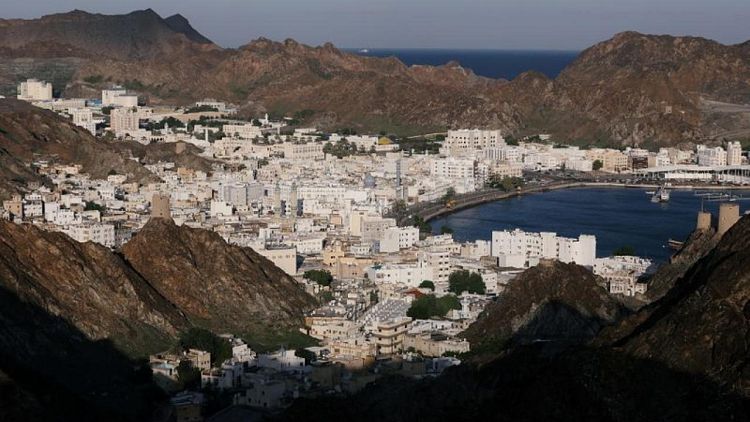By Davide Barbuscia and Lisa Barrington
DUBAI - Oman may be rowing back on an austerity plan to fix its shaky finances in the face of protests over unemployment but investors are cutting the Gulf state's new ruler some slack for now.
Sultan Haitham, who acceded to the throne in January 2020, promised last week on the third day of rare demonstrations in several towns and cities to create 32,000 jobs and subsidise private companies that take on Omanis.
But the move did not trigger any major drop in the price of Oman's bonds, with investors saying some flexibility in its fiscal adjustment was expected to guarantee social stability in a country also hit by protests over jobs and corruption in 2011.
"The market reaction is reflecting an understanding that significant reform, particularly as it relates to taxation in a region that has limited precedence, will meet obstacles, but has not been materially derailed," said Sharif Eid, a portfolio manager at Franklin Templeton Investments.
"Short term, measured adjustments are to be expected, particularly as they may impact social factors," he said.
Oman's government bonds due in 2047 yielded 6.9% at the end of last week, only slightly higher than 6.7% before the protests. In March last year, the yield hit nearly 12% as the coronavirus outbreak triggered a collapse in crude prices.
Oman's austerity measures unveiled last year are seen as crucial for maintaining the cash-strapped country's ability to access international debt markets ahead of debt redemptions worth about $11 billion this year and next.
Oman is among the weakest countries financially in the oil-rich region and more vulnerable to swings in the price of hydrocarbons, a sector that accounted for about a third of its gross domestic product (GDP) in 2019.
Since the oil price crash in 2014, its debt to GDP ratio has leapt from about 15% in 2015 to 80% last year, while Oman's plans to diversify revenue away from oil and to reduce spending on its bloated public sector have lagged.
Oman's finance ministry and central bank did not respond to requests for comment about the country's ability to prop up its economy in the face of financial constraints.
BUMPY ROAD AHEAD
The medium-term fiscal plan announced in October, which included the introduction of a value-added tax (VAT) in April, has reassured investors, helping Oman to raise billions of dollars in bonds and loans this year.
"Oman provided comfortable levels of information since late last year that supported the market and are further supported by oil prices at $70 per barrel, which significantly reduced their funding gap," said Zeina Rizk, executive director, fixed-income asset management, at Arqaam Capital.
"Also, Oman raised most of its budget funding needs this year, which is also supportive," she said.
Oman plans to reduce its deficit from more than 4 billion rials ($10.4 billion) in 2020, or 15.8% of GDP, to 537 million rials in 2024, which would be equivalent to 1.7% of GDP.
Debt to GDP is expected to remain at about 80% by 2024, but in the absence of the medium-term fiscal plan it would have shot up to 128%, the ministry of finance has said.
Oman is also aiming to increase non-oil revenue to 35% of the overall total in the coming years from 28% last year.
The fiscal plan does allow for some time to launch particularly sensitive steps such as a personal income tax on high earners, which Oman said it was considering for 2022 in what would be a first for the Gulf region.
Still, while the unrest that erupted last week appears to have abated after a heavy security response, it is a sign that Oman's efforts to contain state deficits and debts may slow down to accommodate job demands.
Oman's unemployment rate spiked to a record 5% last year and youth unemployment is over 10%, according to World Bank data.
"The road to fiscal consolidation was unlikely to be smooth and the concessions made by the authorities will slow the rate of adjustment," said Scott Livermore, Middle East chief economist at research group Oxford Economics.
Tariq Haq, senior employment policy specialist for Arab states at the International Labour Organization, said Oman needed to develop a medium- to long-term employment policy.
"The provision of government jobs as an emergency response is not a sustainable substitute for a more comprehensive reform of the labour market, which needs to accompany structural reform of the Omani economy more broadly," he said.
FINE-TUNING ON THE CARDS
In addition to introducing VAT and gradually raising water and electricity tariffs this year, Oman cut its civilian and military spending in 2020 and has budgeted for further declines this year.
However, an expectation that such ambitious reforms would have to be balanced against socio-economic pressures has been largely factored in by investors and credit ratings agencies.
Fitch said last month its outlook for Oman - which is rated sub-investment grade by all major agencies - was negative owing to "risks to sustained enactment of fiscal consolidation plans given the challenging economic and social context".
Oman may use government spending to dampen some of the social fallout from its efforts to diversify revenue but the direction of reforms will not change, said Livermore.
"The Omani authorities have little choice but to remain committed to medium-term fiscal adjustment, although there may be some fine-tuning on how this is achieved."
Still, some investors said how Oman reacts to any resurgence of social unrest and other economic challenges would need to be monitored closely.
"Investors evaluated the medium-term consolidation plan in Oman with relative relief as it provided some short-term relief for the fiscal figures," said Sergey Dergachev, a fund manager at Union Investment.
"But Oman also faces other risks, including a challenging tourism sector outlook and inflationary pressures, all in parallel to the employment situation, which needs to be watched," he said.
($1 = 0.3849 Omani rials)



